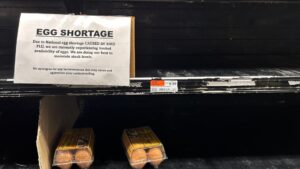Understanding the Recent Surge in Egg Prices: What You Need to Know
In an eye-opening development for grocery shoppers, recent reports indicate that wholesale egg prices in the U.S. have skyrocketed, breaking previous records and possibly leading to further sticker shock at your local supermarket. At Extreme Investor Network, we believe in equipping our readers with insights to make informed financial decisions, especially during such turbulent economic times. Let’s delve into the reasons behind this egg price spike, its implications for consumers, and how to navigate this new landscape.
Record-Breaking Prices: An Overview
As of late 2024, the price for wholesale large, white shell eggs hit an astonishing $8 per dozen. To put this in perspective, this is a significant leap from the previous high of $5.46 per dozen seen in December 2022. Industry analysts attribute this surge to the ongoing avian flu outbreak, which has severely impacted egg supply and driven up prices across the board.
As consumers, we often feel the effects of such price hikes within a few weeks, as there’s typically a lag before wholesale prices translate to retail prices. The way these prices reflect in stores varies significantly depending on the retailer, with some larger chains better positioned to absorb costs than smaller ones.
The Avian Flu Crisis: What’s Driving the Upward Trend?
The primary culprit behind the current egg price inflation is highly pathogenic avian influenza, commonly known as bird flu. This infectious disease has led to the culling of millions of chickens at commercial egg farms, drastically reducing the egg supply. Reports indicate that over 40 million egg-laying chickens have perished due to the outbreak, representing roughly 13% of the national total.
The economics at play are straightforward: with a significantly reduced supply and continued demand, prices are bound to climb. Current inventories of shell eggs are about 15% to 16% lower than the five-year average, according to the U.S. Department of Agriculture.
The Broader Economic Context
While overall inflation has eased for many consumer goods, egg prices have consistently outpaced general rates of inflation, creating unique challenges for households. For example, in December 2023, the average price paid for a dozen large, grade A eggs was about $4.15, marking a 65% increase from roughly $2.51 in December 2020.
This exorbitant increase has forced retailers, including major brands like Trader Joe’s and Costco, to implement buying limits on eggs to manage what they can sell. Restaurants have also felt the pinch, with chains like the Waffle House charging additional fees for egg orders to cover rising costs.
Navigating the New Landscape: Consumer Strategies
-
Shop Smart: To mitigate the financial impact of rising egg prices, consider buying eggs from larger national retailers that may have more flexibility in pricing. They often have strategies in place to absorb wholesale increases better than smaller, independent stores.
-
Buying in Bulk: If your household uses a significant number of eggs, buying in bulk can also help you save in the long run. Look for sales or membership discounts that can offset some of the price increases.
-
Product Alternatives: Given the volatility in egg prices, consider exploring alternative sources of protein that might be less affected by the current crisis, such as beans, legumes, or plant-based products.
- Stay Informed: Sign up for alerts from your favorite stores to track when prices drop or promotional sales occur. This way, you can buy at a lower cost and build a reserve when prices normalize.
Why Chicken Prices Are Holding Steady
Interestingly, while egg prices soar, chicken prices have not followed the same trajectory. This is largely due to the differential impact of avian flu on the poultry sector. As of now, broilers (chickens raised for meat) have experienced significantly fewer deaths from the disease compared to layers (chickens raised for eggs).
Experts point out that about 7.5 million broilers have died from bird flu, markedly less than the 20 million egg layers. This discrepancy explains why the prices of chicken remain relatively stable compared to eggs, thus providing a financial opportunity for consumers during this challenging period.
Conclusion
The steep rise in egg prices presents a unique challenge for consumers in an otherwise easing inflation environment. At Extreme Investor Network, we encourage readers to be proactive and strategic in their shopping habits and meal planning. By staying informed and understanding the factors at play, you can mitigate the impact of price fluctuations and make empowered financial decisions for your household. Keep visiting our site for more insights on managing your personal finances effectively in uncertain times!

